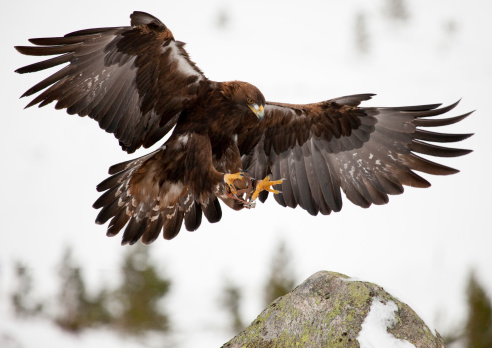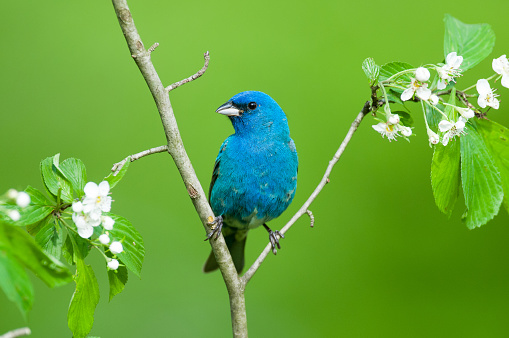Desert regions are unique in their climates and vegetation. The desert heats up in summer when temperatures soar. Many parts of the desert lack water. But desert birds can survive in this hot environment. They are one the most resilient animals on our planet. You might find a Desert Sparrow singing in the midst of thorny shrubs or a Cactus Wren on the sand. We’ll discuss the different desert birds around the world.
The unique adaptations of desert birds make them feel at home in the desert. To avoid water loss due to exhaustion, they stay in the shade throughout the day. They have efficient kidneys that produce minimal liquid. Their water content is mainly obtained from moisture found in foods like nectar, fruit, and insects, as well as other prey. Let’s take a look at the different types of birds that live in deserts.
Desert Birds
- Falcon
Peregrine Falcon, a large and powerful mid-sized raptor, can nosedive at amazing speeds to capture its prey. These birds are about the same size as an adult crow. It can catch birds of prey mid-flight by attacking them. Falcons live in rock cliffs, and are able to spot prey and chase it quickly. The plumes, also called “flags”, are attached to the legs of falcons. They also have a well-developed beak notch. Some falcons can dive from the sky at speeds of up to 200 miles an hour, while chowing down on prey.
- Gambel Quail
It is found in the desert areas of Central America and Mexico. This bird is small and mainly lives on the ground. These birds are able to survive in hot deserts, and in thick vegetation. These birds are easily identifiable by their forward-bending plumage, top knots of feathers, and soaring style. They can travel at high speeds in desert scrubs and bushes looking for food. If water is available, they will nest near water sources. They are quick runners and employ the camouflage technique in order to protect themselves from predators.
- Sand Grouse
Sand Grouse look a lot like pigeons, but they have longer pointed tails. These birds live in some of the most dry areas on Earth. These birds eat grasslands, scrub, and deserts. This bird has a thick layer of underdown that protects it from extreme temperatures.
They are one of the most resilient desert birds, making many long flights each day between their feeding grounds and water pools. Their unique method of collecting water for their nestlings is called “rocking.” A male grouse will visit a water source and make sideways moves in the water. Then, it will shake its feathers in the water. This is actually their way of filling their feathers with water, which they then return to their nests.
Their belly feathers have tough, coiled hair extensions that look like a comb. They can store 25 ml (or almost two tablespoons) of water. They can carry this water back to their chicks from their nest.
- Desert Lark
The Desert Lark breeds in deserts or semi-deserts, from Morocco to western India. This includes the Sahara in Africa and Iran, as well as Afghanistan. They are about 15 cm in length and don’t stay in large groups. Their head is large and their bill is strong. Their plumage matches the colour of desert soil perfectly and is the best example for soil camouflage. They build their nests in the stony desert regions. These birds are well-known for their soft, melodious calls and song that sounds like a flute.
- Greater Roadrunner
The Greater Roadrunner, a long-legged bird belonging to the cuckoo tribe that lives in the Southwest United States and Mexico, is the Greater Roadrunner. They are able to thrive in harsh desert landscapes like the Desert Southwest. They can run and walk on the ground. Flying is only possible when necessary. When chasing prey, they can run up to 15 mph. Sometimes they can outrun humans and kill rattlesnakes.
Roadrunners can reach a length of up to 2 feet from their tail tip to their bill. Their crest is a bushy, blue-black with a spotted plumage. They blend well into the desert scrubs because of their colors. They secrete thick salty solutions through a special gland located in front of their eyes. This is how they excrete water without releasing too much.
- Burrowing Owl
The Burrowing Owl, a small, open-legged owl, is found in the dry, open landscapes throughout Florida, Central America, and Mexico. They hunt in the morning and nest and roost underground, which prairie dogs dig. They perch on high perches, and then swoop down when they spot prey. They can fly high enough to capture prey in flight. They are characterized by thick brown feathers and yellow eyes. It stands tall when agitated and bows down abruptly when it is agitated.
- Gila Woodpecker
The Gila woodpecker is another adaptive bird of desert, found abundantly in the Southwestern United States’ desert areas in California, Arizona and Nevada. The medium-sized woodpecker bird of this species is greyish-brown and has black-and-white spotted wings. A red spot on the crown of male woodpeckers can be used to identify them. The bright red eyes of female woodpeckers are a sign that they are male. They are loud birds and live on huge cactus. These desert birds migrate to warmer parts of the South USA during winter.
- Golden Eagle
Golden Eagles, a popular and widely-reported eagle species are excellent birds to prey. Their plumage is light brown and dark brown. Their wings and tails have distinct white markings. Its powerful talons, beak and hunting skills will help you determine its hunting prowess. It hunts small animals such as squirrels and rabbits and can fly up to 150 mph to catch prey. They are capable of attacking animals larger than they, such as livestock and deer.
- Ostrich
We all know the ostriches, the large flightless birds that live in the dry and arid regions. They can be found roaming the African savannahs and desert lands. These large birds can run up 31 miles an hour and are very strong runners. These birds have powerful legs and sharp claws.
They can walk for up to 10 to 16 miles in long strides. They are able to eat the desert vegetation, which is very sparse, and they get their water mostly from it. They are timid birds and show defensive behavior. They are observant of predators and will act invisibly if they see them.
- Cactus Wren
The Arizona state bird is the Cactus Wren, which can be found in both the United States and Mexico’s southwestern deserts. The large wrens are brown in plumage and have black and white spots. Even their necks have distinctive white eyebrows. These birds can be found among desert plants and prickly pear cactus. These birds are adaptable and don’t migrate in the desert winters. To keep their feathers trimmed, they are known to take desert dust sand baths.
11.Lucifer Hummingbird
Lucifer Hummingbird, also known as Lucifer Hummingbird, is a medium-sized desert bird. It can grow up to 10 cm in length. This bird species was once found in high-altitude areas in northern Mexico and the Southwest United States. It can be found in areas of deserts and arid regions with agave plants in southwestern United States. It has a long, curved bill and small wings. The white streak behind the eye is a sign of its appearance. An iridescent plumage distinguishes the male from the female. Bird species mainly eat desert flowers, spiders, and small insects.
12.Verdin
Verdin is the only bird to belong to the genus Auriparus. One of the desert birds constructed nests for breeding and roosting. This small bird can grow to 4.5 inches (11 cm) long. The appearance is simple. The body is gray overall, while the adults have a bright yellow head and rufous shoulder patches. They used to eat in shrub-land, scrubby outcrops and areas where insects and berries are abundant.
13.Indigo Bunting
Indigo Bunting, a small bird of the Cardinalidae family, is one example. It is most commonly seen from southern Canada to northern Florida during its breeding season. During winter, it is more common in southern Florida to northern South America. It can grow to 11.5-13 cm in height and is closely related with the lazuli bunting. The male species is brightly coloured in summer and has bright plumage that is brightly coloured during breeding season. However, the winters are brown. The females are always brown throughout the year. The summer months are dominated by insects, while the winter months are dominated by seeds.
14.Chinese hwamei
The Chinese hwamei, also known as the melodious laughing thrush, is one of the most common desert birds found in eastern Asia. It belongs to the Leiothrichidae family. Hwamei, which means “painted eyebrow”, is a Chinese name. It has an distinctive marking around its eyes. It can grow to 21-25 cm in length. It has broad, rounded wings with a fan-shaped tail and fan-shaped tail. The bird species’ plumage is reddish brown in colour with dark streaks at the crown, back, and throat. It can sing beautiful songs, making it a popular cage bird.
15.Ferruginous Pygmy-Owl
Ferruginous Pygmy Owl is a smaller species. It is most commonly found in southern Texas and south-central Arizona. These areas have a wide variety of semi-open woodland habitats. It is a Strigidae species, which are the typical owls. It preyed on many birds, lizards and mammals. It can grow to 15 cm in length and its whistle can be imitated by birdwatchers. This is used to attract small birds to the pygmy Owls.
16.Rosy-faced Lovebird
The beautiful desert bird known as the rosy faced lovebird, also called the peach-faced or rosy-collared lovebird, is found in the Namib Desert region of southern Africa. They are social birds, and can often be seen in small groups. The plumage of both male and female is identical. Their unique sleeping position is that they lie side-by-side, with their faces facing in the direction of each other. It was first described in 1818 by Louis Jean Pierre Vieillot, a French ornithologist.


